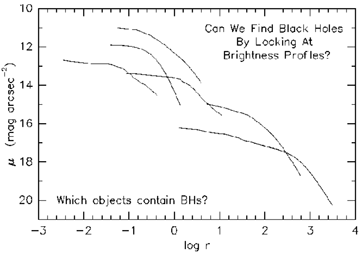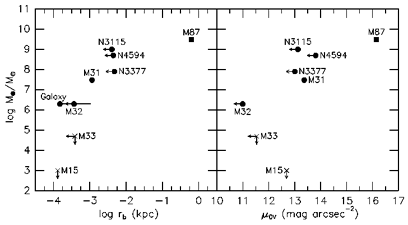Copyright © 1995 by Annual Reviews. All rights reserved
| Annu. Rev. Astron. Astrophys. 1995. 33:
581-624 Copyright © 1995 by Annual Reviews. All rights reserved |
Many papers argue that the brightness profiles of particular galaxies imply that they contain BHs (e.g., Young et al. 1978, 1979; Lauer et al. 1991a, 1992a, b; Fabbiano et al. 1994). The arguments are variations on the theme that BHs produce cuspy potentials and hence cuspy density distributions. This section shows why such arguments are inconclusive.
Figure 1 shows projected brightness profiles of six stellar systems. Identifications are omitted. Which objects show evidence for a BH? Are they the ones with high central densities or small core radii?
The answers are in Figure 2. M31 and M32 show
stellar-dynamical
evidence for high central mass-to-light ratios. Deconvolved HST
profiles are
shown for both galaxies. To be sure, they are very compact. But M33's
nucleus
(Kormendy &
McClure 1993)
is more compact than that of M31. It is as
small as the limit on a core in M32, and it is almost as dense.
And yet we know that M33 does not contain a supermassive BH.
Kormendy &
McClure (1993)
find that the central velocity dispersion is only  = 21 ± 3 km s-1.
Therefore MBH
= 21 ± 3 km s-1.
Therefore MBH  5 x 104
M
5 x 104
M (Section 4.8).
(Section 4.8).
In contrast, M87 contains an MDO of mass MBH ~
3 x 109 M (Sargent et
al. 1978;
Harms et
al. 1994).
But its highest measured
surface brightness is more than 50 times lower than that of the M33 nucleus,
and its core is more than a thousand times larger. At radii r
(Sargent et
al. 1978;
Harms et
al. 1994).
But its highest measured
surface brightness is more than 50 times lower than that of the M33 nucleus,
and its core is more than a thousand times larger. At radii r
 G MBH /
G MBH /  2
2  1" that are dominated by the BH
(Peebles 1972;
Bahcall & Wolf 1976),
M87 does not even reach the
surface brightnesses seen in normal ellipticals like NGC 3379, in which
there is no evidence (circumstantial or otherwise) for a BH.
1" that are dominated by the BH
(Peebles 1972;
Bahcall & Wolf 1976),
M87 does not even reach the
surface brightnesses seen in normal ellipticals like NGC 3379, in which
there is no evidence (circumstantial or otherwise) for a BH.

Figure 1. Seeing-corrected, mean brightness profiles of six stellar systems. Can you identify the ones that contain supermassive BHs? |
Finally, the core-collapsed globular cluster M15
(Lauer et
al. 1991b)
has a smaller core radius than any galactic nucleus. Its central density is
much higher than that of M87. But it shows no evidence for a BH. From
Newell et
al. (1976),
Peterson et
al. (1989),
Meylan & Pryor
(1993),
Dubath et
al. (1994),
Dubath & Meylan
(1994),
we adopt MBH < 103
M .
.
To emphasize this further, Figure 3 shows BH mass versus core parameters as measured with HST (Kormendy et al. 1994; Lauer et al. 1995; Faber et al. 1995). The correlations are opposite to what we expect. Far from making cores compact, larger BH masses are associated with larger cores and lower maximum densities. These correlations may be upper envelopes of a distribution: only two upper limits are plotted.
The explanation of Figure 3 becomes clear when we plot
MBH against bulge
luminosity (Figure 14 in
Section 6). There is a good correlation:
more massive
BHs are found in more luminous bulges. But we know that more luminous bulges
have larger rb  rc and fainter
µ0V: these are projections of
the fundamental plane correlations (see
Kormendy &
Djorgovski 1989
for a review). Therefore at 0".1 resolution it is the virial theorem
controlling the formation of the whole galaxy
(Faber et
al. 1987;
Djorgovski et
al. 1988)
and not MBH that determines the compactness of the
core. BH cusps may dominate over the fundamental plane at still smaller
radii, but we will need better resolution to see this.
rc and fainter
µ0V: these are projections of
the fundamental plane correlations (see
Kormendy &
Djorgovski 1989
for a review). Therefore at 0".1 resolution it is the virial theorem
controlling the formation of the whole galaxy
(Faber et
al. 1987;
Djorgovski et
al. 1988)
and not MBH that determines the compactness of the
core. BH cusps may dominate over the fundamental plane at still smaller
radii, but we will need better resolution to see this.

Figure 2. Figure 1 with object names and BH masses identified. |

Figure 3. BH mass as a function of profile break radius rb (formerly core radius rc) and maximum observed surface brightness µ0V (cf. Figure 4 in Kormendy 1994). HST measurements of rb and µ0V are from Faber et al. (1995). Filled circles and squares show objects with stellar- and gas-dynamical evidence for MDOs. Upper limits on MBH are plotted as crosses. Strong limits on core parameters are indicated by arrows. For the Galaxy, rb is from rc as given in Allen (1994); Eckart et al. (1994); Genzel et al. (1994); and Rieke & Rieke (1994); the horizontal error bar ends at the larger of two values quoted by Rieke and Rieke and by Allen. |
We conclude that evidence for BHs based only on surface brightness profiles is not evidence at all (see also Phinney 1989). This includes arguments like: (a) the profile is cuspy; (b) central densities are high and core radii are small; (c) the central relaxation time is short, so core collapse is likely. These arguments apply most strongly to M33, and in M33, a supermassive BH can be excluded. Unless kinematic measurements prove that mass-to-light ratios rise to large values near the center, high central densities are most likely to be evidence for dissipation (Phinney 1989; Kormendy 1989). Dissipation can produce arbitrarily high densities. Witness planets.